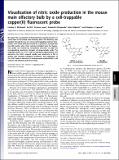| dc.contributor.author | McQuade, Lindsey E. | |
| dc.contributor.author | Ma, Jie | |
| dc.contributor.author | Lowe, Graeme | |
| dc.contributor.author | Ghatpande, Ambarish | |
| dc.contributor.author | Gelperin, Alan | |
| dc.contributor.author | Lippard, Stephen J. | |
| dc.date.accessioned | 2013-11-15T20:19:07Z | |
| dc.date.available | 2013-11-15T20:19:07Z | |
| dc.date.issued | 2010-05 | |
| dc.date.submitted | 2009-12 | |
| dc.identifier.issn | 0027-8424 | |
| dc.identifier.issn | 1091-6490 | |
| dc.identifier.uri | http://hdl.handle.net/1721.1/82146 | |
| dc.description.abstract | We report the visualization of NO production using fluorescence in tissue slices of the mouse main olfactory bulb. This discovery was possible through the use of a novel, cell-trappable probe for intracellular nitric oxide detection based on a symmetric scaffold with two NO-reactive sites. Ester moieties installed onto the fluorescent probe are cleaved by intracellular esterases to yield the corresponding negatively charged, cell-impermeable acids. The trappable probe Cu[subscript 2](FL2E) and the membrane-impermeable acid derivative Cu[subscript 2](FL2A) respond rapidly and selectively to NO in buffers that simulate biological conditions, and application of Cu[subscript 2](FL2E) leads to detection of endogenously produced NO in cell cultures and olfactory bulb brain slices. | en_US |
| dc.description.sponsorship | National Science Foundation (U.S.) (Grant CHE-061194) | en_US |
| dc.language.iso | en_US | |
| dc.publisher | National Academy of Sciences (U.S.) | en_US |
| dc.relation.isversionof | http://dx.doi.org/10.1073/pnas.0914794107 | en_US |
| dc.rights | Article is made available in accordance with the publisher's policy and may be subject to US copyright law. Please refer to the publisher's site for terms of use. | en_US |
| dc.source | PNAS | en_US |
| dc.title | Visualization of nitric oxide production in the mouse main olfactory bulb by a cell-trappable copper(II) fluorescent probe | en_US |
| dc.type | Article | en_US |
| dc.identifier.citation | McQuade, L. E., J. Ma, G. Lowe, A. Ghatpande, A. Gelperin, and S. J. Lippard. “Visualization of nitric oxide production in the mouse main olfactory bulb by a cell-trappable copper(II) fluorescent probe.” Proceedings of the National Academy of Sciences 107, no. 19 (May 11, 2010): 8525-8530. | en_US |
| dc.contributor.department | Massachusetts Institute of Technology. Department of Chemistry | en_US |
| dc.contributor.mitauthor | McQuade, Lindsey E. | en_US |
| dc.contributor.mitauthor | Lippard, Stephen J. | en_US |
| dc.relation.journal | Proceedings of the National Academy of Sciences | en_US |
| dc.eprint.version | Final published version | en_US |
| dc.type.uri | http://purl.org/eprint/type/JournalArticle | en_US |
| eprint.status | http://purl.org/eprint/status/PeerReviewed | en_US |
| dspace.orderedauthors | McQuade, L. E.; Ma, J.; Lowe, G.; Ghatpande, A.; Gelperin, A.; Lippard, S. J. | en_US |
| dc.identifier.orcid | https://orcid.org/0000-0002-2693-4982 | |
| mit.license | PUBLISHER_POLICY | en_US |
| mit.metadata.status | Complete | |
